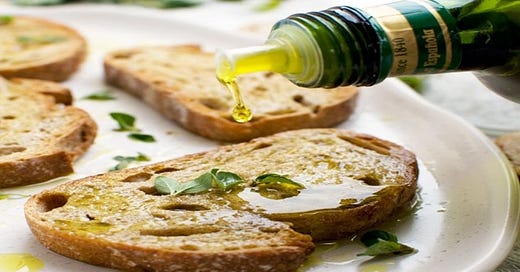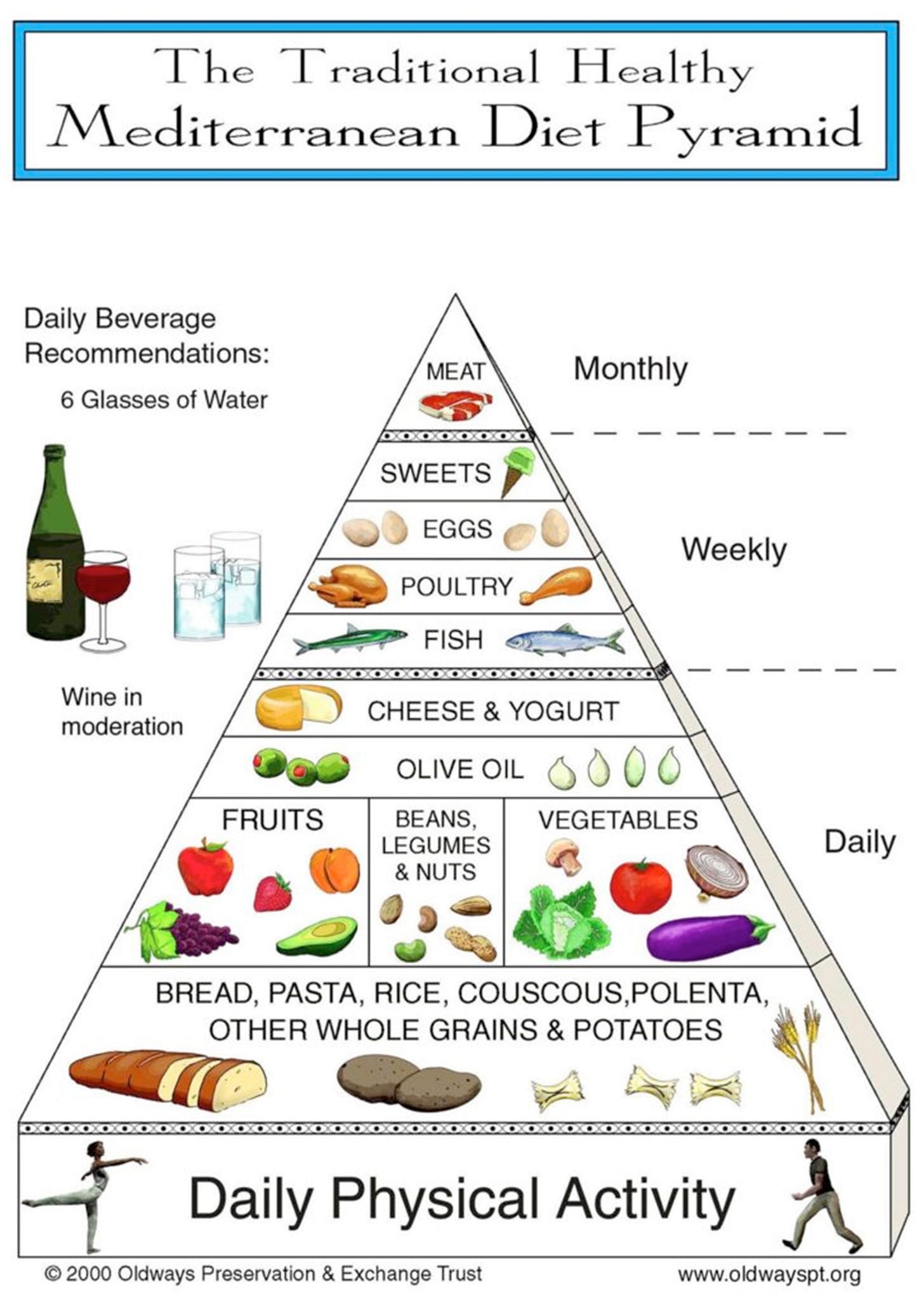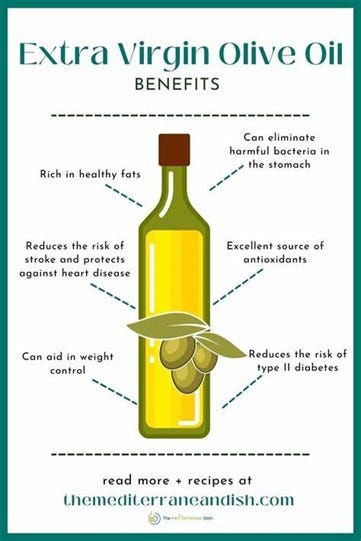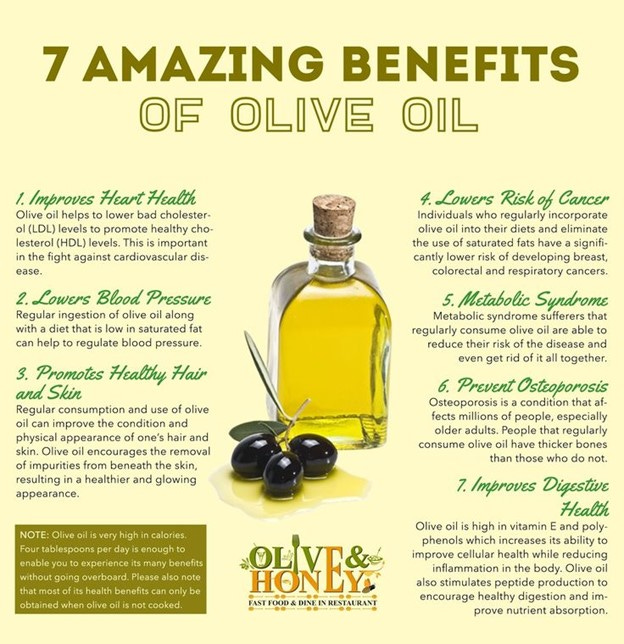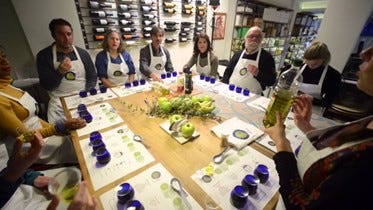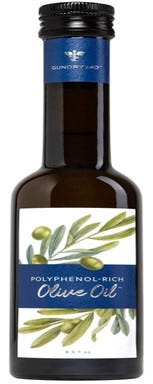OLIVE OIL: A VERY HEALTHY FAT
I must confess that I am a lover of olive oil. For me, crusty bread, heated up until its crispy and then smothered with some extra virgin olive oil (EVOO) and some sea salt and garlic is better than almost any desert.
Olive oil is well known for its many health benefits and is an integral part of the Mediterranean diet which also includes large amounts of vegetables, fruit, nuts, seeds, grains, beans, bread, eggs, cheese, olive oil as the primary fat, fish more so than red meat or chicken, all fresh ingredients, nothing processed, frozen or packaged. It is one of the most popular diets in the world and is touted as being one of the healthiest.
Besides eating healthy non-processed foods, many of these are also organic which is an added plus, since they don’t contain pesticides, fungicides, herbicides, and other industrial farming chemicals that your body has to detoxify and eliminate.
Deserts are not a daily or several times a day as in the Standard American Diet (SAD), but rather are weekly. For a sweet, most countries in the Mediterranean region will use fruits such as dates, figs, oranges, grapes, and berries. These are better for you since they contain a whole host of other plant based or phytonutrients, as well as fiber which slows the entry of sugar from these fruits into your blood, preventing spikes in insulin and its resulting obesity.
The Mediterranean diet also encourages daily physical activity. When I went to medical school in Italy, I watched the Italians not only not rush through their meals, enjoying a leisurely one- or two-hour dinner with family and friends, but also take a nice evening stroll in the center of town, where they met up with friends and had lively conversations. That is a very healthy way to eat and live.
Interactions with friends and family, with children and grandchildren are a wonderful stress reducer and I am sure contribute to their happiness and longevity. What are we rushing through our lives for here in the United States, and most of the western world? We would be much better served by eating a leisurely evening meal and having lively conversations.
Eating slowly and chewing your food, washing it down with a little wine, is a much healthier way to eat. Ironically, a little wine (or alcohol) is better for you than no wine! Let that sink in, the only problem with that is: how much is a little wine?
Italians usually drink one or two glasses of wine, and rarely did I ever see any public drunkenness (of course we American medical students were sometimes the exception to that rule). LOL.
HOW IS OLIVE OIL EXTRACTED FROM OLIVES?
The production of olive oil goes back at least four centuries before Christ. Olive trees are native to the entire Mediterranean area, and every country produces their own olive oil.
Historically, olives were picked while still green and crushed into pulp between two large grind stones that revolve in different directions. Separating the oil from the pomace (the pits, pulp and other solids) involved putting it into woven mesh bags that were in turn squeezed between stone weights.
This expressed the oil and left the pomace solids behind. Hot water was then poured into the bags to remove any remaining oil. This water/olive oil combination was collected in stone pits, where the oil rose to the surface and was skimmed off and stored in terra cotta amphorae.
Kinky Fact/Nerd Food: Why did amphorae have pointed bases? The Ancient Greeks and Romans used amphorae for transport and storage of wine, oil, and fish sauce. For stacking purposes during sea voyages of several hundred kilometers, the amphora bases were pointed, allowing the upright containers to be stacked in layers, one-layer functioning as the base of the next one.
Ancient Greek Amphora for holding olive oil or wine.
WHAT ARE THE DIFFERENT TYPES OF OLIVE OIL AND HOW ARE THEY USED?
Extra virgin olive oil: the most flavorful and purest form of olive oil, with a low acidity level and a high antioxidant content. It is ideal for salads, dips, and drizzling over dishes.
Virgin olive oil: a less pure and milder form of olive oil, with a slightly higher acidity level and a lower antioxidant content. It is suitable for sautéing, baking, and roasting.
Light and extra light olive oil: refined olive oils that have a neutral flavor and a high smoke point. They are good for frying, grilling, and baking.
Pure or regular olive oil: a blend of refined and virgin olive oils, with a balanced flavor and a medium smoke point. It can be used for cooking, baking, and dressing.
Olive pomace oil: a low-quality oil extracted from the leftover pulp of olives, with a bland taste and a low smoke point. It is mainly used for industrial purposes.
How is Extra Virgin Olive Oil Made and How is it Different from Other Olive Oil?
Extra Virgin Olive Oil (EVOO) is by far the healthiest of all forms of olive oil.
EVOO is made using the following steps:
1. Harvest and collection of olives.
2. Storage in oil mills.
3. Cold extraction process.
4. Analysis and quality control.
5. Packaging of the final product.
The first step is harvesting the olives. The olives are then stored in oil mills and the oil is extracted from the fruit using a cold extraction process. After processing, the EVOO can be finished either by filtration or racking.
What is racking that I mentioned above? Racking in the context of olive oil production refers to a crucial step where the oil is carefully pumped from the top of a container into a clean vessel, leaving behind any sediment and water that have settled at the bottom. This process helps separate the high-quality oil from impurities, ensuring a better final product. The longer the producer waits before racking, the easier it becomes to separate the oil from the sediment, but this also means more time during which the oil may be in contact with the impurities.
The final product is then analyzed and undergoes strict quality control standards before being packaged and given the label EVOO.
The production of EVOO involves refining the oil as little as possible and not utilizing any heat or chemical means of extracting the oil, thus leaving it “extra virgin”. Not using heat but rather “cold pressing” preserves the fruity flavor and protects many of the ingredients from degradation. EVOO is the healthiest, most expensive form of olive oil since it is the closest to pure, unrefined. Many of the health enhancing ingredients such as polyphenols are preserved using these production practices.
WHY IS OLIVE OIL HEALTHY FOR YOU?
Let’s take a deep dive into Olive oil and its many health benefits. What does olive oil contain that makes it healthy for us?
POLYPHENOLS
Olive oil is very rich in antioxidants, especially heart healthy polyphenols. Olive oil contains about twenty different types of polyphenols.
Polyphenols help keep plants healthy. They make sure the plant can absorb the sunlight it needs to grow, and they protect the plant from disease.
When you eat polyphenol-rich plants, those same polyphenols that keep the plant healthy do similar good for your body. Polyphenols have two main benefits for your body: They’re antioxidants and anti-inflammatory.
As an antioxidant, polyphenols help fight free radicals (unstable molecules) in your body. That’s important because a buildup of free radicals damages your cells.
Polyphenols act as a shield around the cell, protecting it from antioxidants. That damage is called oxidative stress, and it can lead to a range of health conditions, like:
Cancer.
Autoimmune disease
Heart disease.
Aging skin.
By the way, don’t try to take polyphenols in supplement form, it doesn’t work very well. The reason being that the polyphenols found in plants are part of an entire plant with a host of other phytonutrients (plant-based nutrients) that work in harmony with each other and isolating them destroys that synergy.
HEALTHY MONOUNSATURATED FATS (MUFA’s)
Monounsaturated fats are very healthy for you and are abbreviated MUFA’s (monounsaturated fatty acids). MUFA’s are found in plant-based foods. MUFA’s are very healthy for you since they lower your risk of heart disease, promote weight loss, improve cholesterol by lowering levels of LDL, and lower blood pressure. If all of that wasn’t enough, they also lower your risk of cancer. MUFA’s also lower your risk of developing diabetes since they improve the function of insulin. They also are involved with lowering inflammation which prevents chronic diseases from developing, since inflammation is always bad. Make EVOO and nuts your source for fats.
NOTE: You only reap the benefits of EVOO when you use it to replace other unhealthy seed oils. Adding EVOO to a diet high in fried and highly processed foods and junk foods will not give you any health benefits, since there are so many bad fats in your diet. Seed oils are always bad for you, examples are:
Seed oils are bad for you for several reasons, the most important being that they contain large amounts of proinflammatory omega-6 fatty acids, which contribute to inflammation. They also promote the production of harmful free radicals, causing cell damage and inflammation. Seed oils are inexpensive and are used quite heavily in processed foods and junk food.
OLEIC ACID AND OLECANTHAL
Olive oil contains oleic acid and oleocanthal. These are polyphenols and as such are very potent anti-inflammatory agents as well as antioxidants. Olecanthal is what gives you a very slight burning sensation in the back of your throat when you swallow olive oil. Olecanthal has such strong anti-inflammatory characteristics that it has been compared to ibuprofen (Motrin, Advil).
VITAMINS E AND K
Olive oil is very rich in both vitamins E and K, which are two fat soluble vitamins that work as antioxidants and also helps clotting of blood.
OLIVE OIL AND ITS WONDERFUL BENEFITS FOR YOUR SKIN AND HAIR
The ancient Greeks and Romans used olive oil extensively for both their skin and hair health. Even in these modern times olive oil is used by many women for its beauty enhancement qualities.
HOW DOES OLIVE OIL COMPARE TO OTHER HEALTHY OILS?
Let’s take a look at how olive oil stacks up against other healthy oils:
You have a choice for what oil you use to cook with but know that each oil has about the same number of calories (around 120) and fat (around 14 g) per tbsp; it’s their fat makeup that differs. Here’s how olive oil nutrition facts compare to those of other culinary oils:
Avocado Oil - Because avocados are mostly made up of MUFAs, avocado oil is the most similar to olive oil nutritionally. It contains 1.6 g of saturated fat, 9.9 g of MUFAs, and 1.9 g of PUFAs.
Canola Oil - A mostly unsaturated fat, canola oil is similar nutritionally to olive oil, particularly because it has 8.9 g of MUFAs. Where it differs is the PUFA content, with canola oil packing 3.9 g. It also contains 1 g of saturated fat.
Grapeseed Oil - This oil is mainly made up of PUFAs (9.5 g), with 2.2 g of MUFAs and just 1.3 g of saturated fat. (Both MUFAs and PUFAs have been linked to heart health by helping to improve blood cholesterol levels.)
Coconut Oil - This tropical oil differs vastly from olive oil. Most of its fats (11.2 g, or about 83 percent) are saturated, and it has less than 1 g of MUFAs and a scant amount (0.2 g) of PUFAs.
HOW THE MEDICAL UNDERGROUND USES OLIVE OIL
When the Medical Underground recommends the use of olive oil, if it is for health benefits and not cooking, I am referring to EVOO (extra virgin olive oil). Since EVOO is by far the healthiest form of olive oil. I have no problem with using olive oil for cooking just not EVOO.
Dry Skin, and Other Skin and Hair Conditions
EVOO has been used by Mediterranean women (whom I think are among the most beautiful in the world, just my humble opinion) for thousands of years for all types of skin conditions, but mostly as a beautifying agent for aging and dry skin. Take seveal drops of EVOO and rub it gently with a circular motion into your skin, do this twice a day. The same thing can be done with dry, frizzy hair, but make sure you are using EVOO.
The Mediterranean Diet
This is by far one of the healthiest diets on the planet. It is also one of the most tasty and satisfying, thus making your daily meals a real enjoyment. For this you will have to shop along the outer isles of the grocery store, avoiding the center of the store and its processed, industrially made “foods”.
Filling your plate with fresh fruits, vegetables, nuts, cheeses, bread, and either fresh butter or EVOO is very healthy. The Medical Underground prefers using EVOO for its polyphenol and other nutrient content. It is a rare win win situation, replacing your other fats with EVOO. It tastes great and is healthy for you.
Daily Shots of EVOO
Certainly, this is an alternative way to get your EVOO and with it all of its health enhancements, but I have to say I prefer to sprinkle it on my salads or other dishes. However, to each his own. If you go this route know that you might get a slight burning sensation in the back of your throat. No worries, this is normal.
Which Olive Oil is Best to Use
You have to be careful in your choice of EVOO, there are many out there which are adulterated with cheaper oils. It is a major problem. Italy has tried to fix this problem by having a bunch of Carbinieri (Italian State Troopers) that actually sit in a building in Rome and test samples of all the EVOO made in Italy.
Incredibly, their palates are so exquisitely sensitive that they can taste most adulterations! There are also many private groups which do the same thing to ensure that absolutely only the best EVOO is labeled as such.
Here in the United States one of the most potent brands of olive oil is from Dr. Gundry, who gets his from an olive orchard in Morocco. It has the highest polyphenol content of any on the market. I have tried it and found it to be a little bitter for my taste, since I prefer fruity olive oils. However, for its health benefits no other EVOO can compare.
Dr. Gundry’s polyphenol rich olive oil is grown in the Atlas Mountains adjacent to the Sahara desert, as such, the olive trees are very stressed out and as a protective mechanism produces a chemical called hydroxytyrosol.
Now the olives that go into Gundry MD olive oil endure brutal growing conditions in the Moroccan desert. This forces the olive trees to produce massive amounts of this hydroxytyrosol in order to survive. The result is an oil that’s dripping with this powerful “Fat-Fighter!” It is a very good thing to have in your diet and helps promote weight loss and drastically decrease your body’s inflammation.
The Medical Underground strongly encourages you to replace seed oils and other unhealthy fats in your diet with polyphenol rich EVOO, it has no downside and so many health benefits, and tastes damn good.
Personally, I am blessed to have patients who are constantly showering gifts on me. Usually, it is something they baked or grew in their gardens. One such patient is from Portugal and still has an olive grove there along with his cork oak tress (from which corks are made by harvesting the layer under the bark).
His name is Henrique Garcia and he has by far the best EVOO I have ever tasted. It is fruity and absolutely delicious, and I truly appreciate when he returns from Portugal every year and brings me a bottle.
My takeaway message for my readers is to replace other seed oils and bad fats in your diet with healthy EVOO and nuts, and skewer your diet as close as you can get to a Mediterranean diet. It tastes great and will enhance your health in so many ways.
Well, this ends another exciting episode of the Medical Underground. If you are not yet a member, please hit that subscribe button and join the Medical Underground.
If you are currently a free subscriber, consider upgrading to a paid subscriber. That goes a very long way in showing me your appreciation for all my hard work every week and is only a couple of bucks a month.
Until our next exciting episode, May God Bless You and Your Entire Family and the United States of America. And for those of you who are believers in Jesus Christ always remember that: Miracle Shall Follow Miracle and Wonders Shall Never Cease.
This disclaimer provides that such medical information is merely information – not advice.
If users need medical advice, they should consult their doctor or other appropriate medical professional.
***Copyright © 2023-24 by Dr. Ralph La Guardia, MD
All rights reserved. This article or any portion thereof
may not be reproduced or used in any manner whatsoever
without the express written permission of the publisher
except for the use of brief quotations in an article review.

